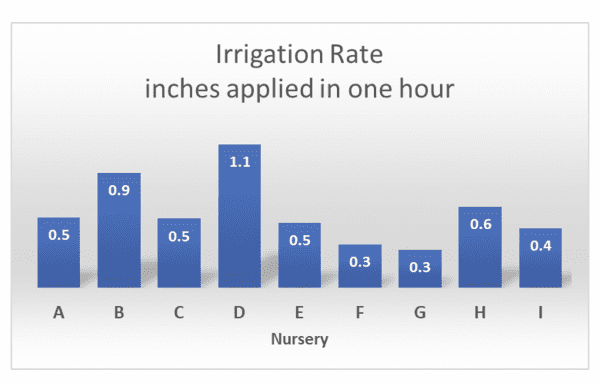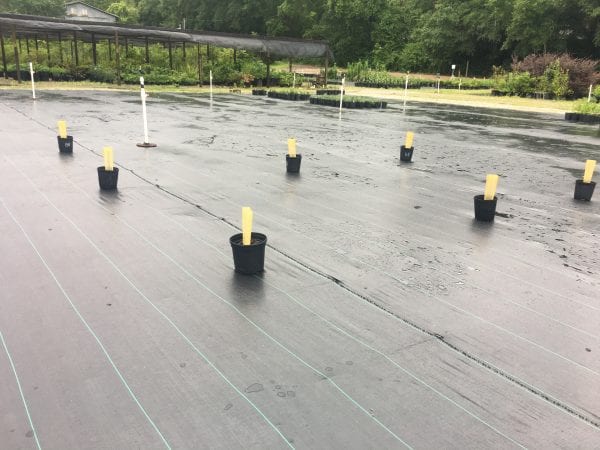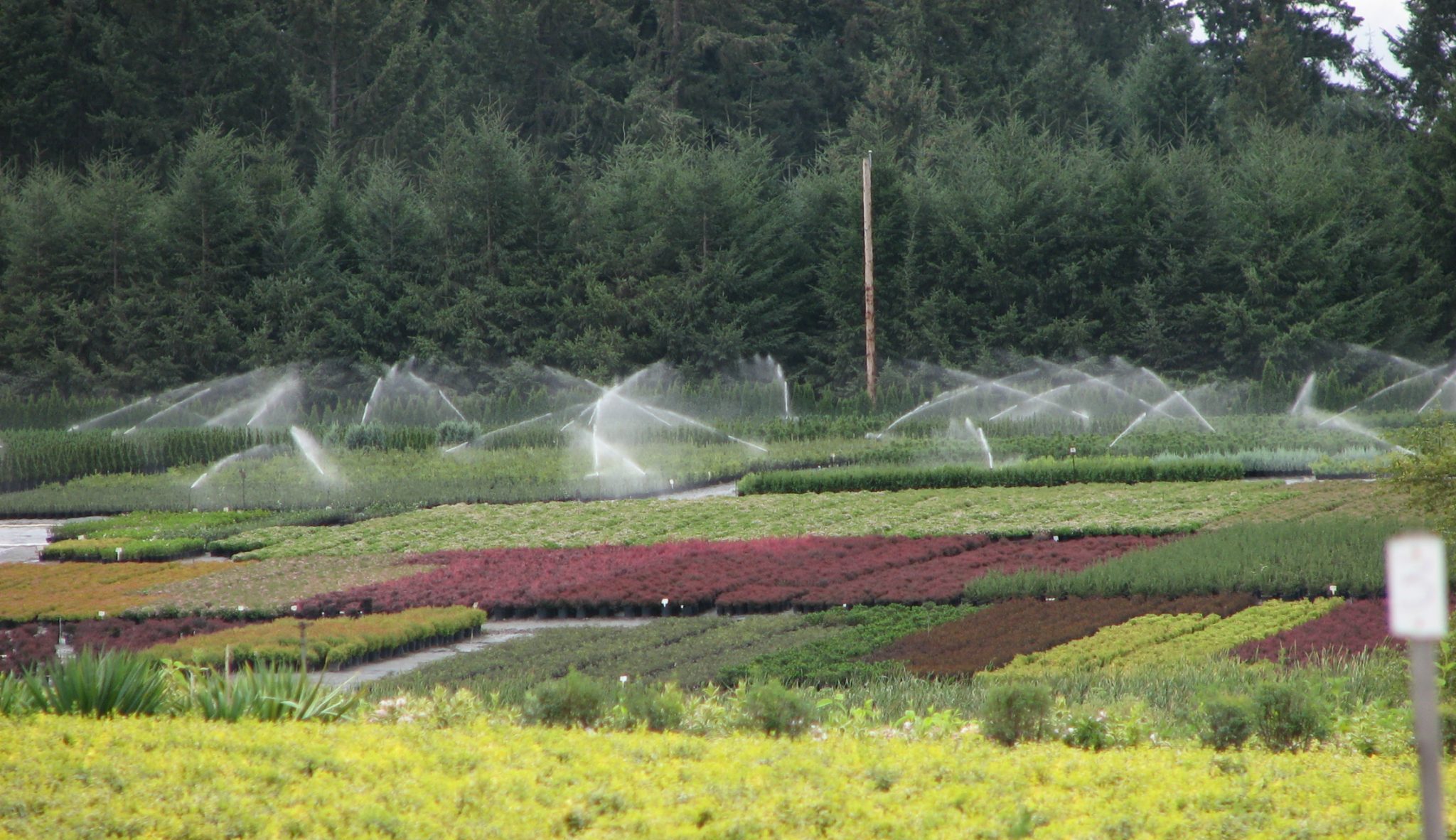Crop Production

In this first of a three-part series, learn how a well-designed and maintained irrigation system can conserve water, reduce pest pressure and fertilizer loss, and even decrease production time. Periodic audits of an overhead system can help you understand how efficiently water is being applied to your nursery.
Why Audit?
It is important to know how much water is distributed over your growing area. The irrigation rate is the amount of water being applied over an hour. This information is usually reported in inches per hour and stems from the way precipitation is measured in acre-inches. One inch of water across an acre equals the volume of 27,154 gallons.
Measuring the rate of irrigation can provide a benchmark on performance and help determine if a problem or inefficiency exists. For example, a clogged feeder line to a pump may reduce the irrigation rate over time, although these changes may not be visually noticeable. A reduction in pump uptake can put a strain on the motor and reduce its lifespan. Knowing the irrigation rate can help with adjustments to run times if more than one system is used at the nursery.
In 2019, Auburn University audited overhead irrigation systems at nine container nurseries across Alabama. Blocks of dwarf yaupon hollies in #3 containers were evaluated to standardize results. Growers were asked to irrigate as they normally would. The results of this study found that irrigation rates widely varied between nurseries, ranging from 0.3 to 1.1 inches per hour (figure 1). Several nurseries had irrigation rates below 0.3 inches per hour indicating a poor design or problems within the system. This data demonstrates not only the variability of irrigation rates among irrigation systems but also the uniformity issues within a system. To determine system uniformity, see Alabama Extension publication ANR-2705, “Auditing Overhead Irrigation Systems in Container Nurseries: Distribution Uniformity.” Many growers stick to industry rules of thumb when deciding how long to irrigate. For many, 30 minutes is standard run time. The data from the audit indicates that run time alone is not the best decision-making tool because the irrigation rate varied widely despite the average run time being 30 minutes.

Figure 1. On-farm irrigation audit of nine Alabama nurseries.
Irrigation Rate
Finding the irrigation rate is a way to estimate how much water is being applied to an irrigation block within a given amount of time. It is usually reported in inches, meaning acre-inches. The irrigation rate can be easily determined using a grid of rain gauges. If rain gauges are not feasible, plastic drinking cups can be used, but this method will require a little more math.

Figure 2. Rain gauges placed in container areas to determine irrigation rate.
Determining Irrigation Rate Using Rain Gauges or Plastic Cups
Rain Gauge Method
- Place a minimum of 8 or more rain gauges in a uniform grid pattern within the irrigation area (figure 2). The more gauges the more accurate the measurement. If plants are present, make sure that the plant canopy does not interfere with water collection. You may need to clear the area around each gauge.
- Once cups are placed, irrigate as you normally would, recording irrigation run time.
- Record the inches collected in each gauge. Note the location of each gauge. If the amount of water in one gauge differs widely from other gauges, it may indicate a malfunctioning irrigation head.
- Find the average application by adding together all the cup volumes and dividing by the number of cups.
- If you’re using rain gauges, use the following equation:
Irrigation rate (in/hr) = (Average application (in))/ ((runtime(min)÷60))

Plastic Cup Method
- Place identical drinking cups in a uniform grid pattern as described for rain gauges.
- Place rocks or other weights in each cup to prevent them from being blown over by the wind.
- Note the location of each cup.
- Run the irrigation and record time.
- Record the volume of each cup in fluid ounces (fl. oz.) (example 1.5, 1.5, 2, 2, 1.5, 2.5, 2, and 0.25 fl. oz.)
- Average the volume of all the cups. Do not use outliers or any cups that are far outside of what appears to be the average. (Remove 0.25 in our example to get an average of 2.14 using the previous example.)
- Determine the surface area of the cup. The area can be determined using the equation:
Area = πr2
Diameter of the cup in inches = _______________ (example: 3-inch cup top)
Diameter ÷ 2 = radius; radius = _____________ in. (example: 1.5 inch radius)
Radius squared(r2) = radius x radius; r2 = ______ (example: 1.5 x 1.5 = 2.25)
Multiply r2 by π (π = 3.14) πr2 = _______ in2 (example 2.25 x π = 7.07 in2)
- Divide the average fl. oz. collected by the area (in2) of the top of the cup to get fl. oz per in2
(example: 2.14 fl. oz. ÷ 7.07 in2 = 0.3 fl. oz. per in2) - Divide the calculated fl. oz. per in2 obtained from the previous step by 0.55. (0.55 is the conversion factor of fl. oz. per in2 to acre inches) (example 0.3 fl. oz. per in2 ÷ 0.55 = 0.55 inches)
- Convert the run time from minutes to hours.
- Divide the acre inches by the run time in hours to get acre inches per hour (example: 40-minute run time = 0.66 hours; 0.55 inches ÷ 0.66 hours = 0.83 inches per hour)
Examples
Using Rain Gauges
- Inches collected in gauges: (0.20 + 0.25 + 0.20 + 0.22 + 0.22 + 0.32 + 0.25 + 0.26 + 0.17 + 0.26 + 0.27 + 0.32) ÷ 12 rain gauges = 0.25 in
- Irrigation run time: 30 minutes ÷ 60 = 0.5 hr
- Irrigation rate = 0.25 in ÷ 0.5 = 0.5 in/hr
Using Collection Cups
- Average volume (fl. oz.) in cups: (1.45 + 1.72 + 1.42 + 0.95 + 1.42 + 1.39 + 1.72 + 1.22 + 1.18 + 1.08 + 1.39 + 1.12) ÷ 12 cups = 1.34 fl. oz.
- Diameter of cup = 3.54 in ÷ 2 = radius of 1.77 in
- Radius squared = 1.77 × 1.77 = 3.13
- Area of cup=π×3.13=9.84in2
- Volume per area: 1.34 fl. oz. ÷ 9.84 in2 = 0.136 fl. oz./in2
- Acre-inches: 0.136 fl.oz. ÷ 0.55 = 0.247 acre-in
- Irrigation run time: 30 minutes; ÷ 60 = 0.5 hr
- 0.247 acre-in ÷ 0.5 = 0.5 in/hr
Conclusion
Measuring irrigation rate can give you a greater understanding of your current system and provide valuable decision-making tools on run times and maintenance. By monitoring and managing irrigation rates, you can schedule irrigation more effectively, conserve water, and save time.


